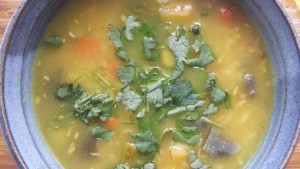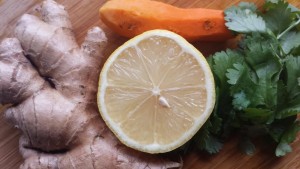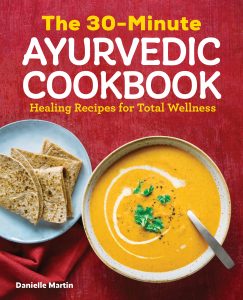 Kitchari is an age old, traditional dish that is not only a staple for Indian meals, but is also a staple for any Ayurvedic cleanse. This versatile, Eastern dish is super nourishing to the body and the mind, and can be made to fit any constitution or dosha type, depending on the spices and veggies that you add.
Kitchari is an age old, traditional dish that is not only a staple for Indian meals, but is also a staple for any Ayurvedic cleanse. This versatile, Eastern dish is super nourishing to the body and the mind, and can be made to fit any constitution or dosha type, depending on the spices and veggies that you add.
This particular recipe is tridoshic, meaning suitable for all body types, and is fitting as a meal, or to aid in a mono-diet cleanse. Kitchari is well known as being easy on the digestive tract and it makes a great meal option for when you are feeling a bit under the weather.
However you decide to incorporate this meal, you can play around with this recipe by adding different spices, veggies, oils, and ghee. I often like to use homemade chicken broth to add flavor as well as essential vitamins and nutrients. So have fun with it and discover the most tasty, healing recipe for you!
Try Our Kitchari Cleansing Kits!
Classic Cleansing Kitchari Recipe
Click here for a printable copy of this recipe.
- Doshic effect: Vata ↓, Pitta ↓, Kapha ↓*
- Vegetarian and Vegan
- Gluten-Free
- Serving: 5 to 6
- Prep Time: 5 to 10 minutes
- Cook Time: 30 to 35 minutes
Ingredients
- 1/2 teaspoon cumin seed, whole
- 1/2 teaspoon brown mustard seed, whole (omit for Pitta)
- 1/2 teaspoon freshly ground black pepper
- 2 teaspoons Agni Churna*
- 1/8 teaspoon cayenne pepper (optional, omit for Pitta)
- 1/4 cup minced onion
- 1 teaspoon finely minced serrano pepper (optional, omit for Pitta)
- 2 tablespoons finely minced ginger
- 2 tablespoons ghee
- 1 cup split mung dal
- 3/4 cup basmati rice (use quinoa for Kapha)
- 6 cups water
- 1/3 cup thinly sliced carrot
- 1/2 cup thinly sliced celery
- 1 cup chopped kale leaves, stemmed
- 1/4 cup finely chopped cilantro
- 1/2 lemon, juiced (use lime for Pitta)
- 3/4 teaspoon pink salt or mineral salt
- Lemon wedges, for garnish (use lime for Pitta)
- Chopped green onion, for garnish
- Ghee, for individual servings
*Replace the Agni Churna with 1 teaspoon turmeric, 1/4 teaspoon cumin powder, and 1/4 teaspoon fennel powder.
Click here for a printable copy of this recipe.
Directions
1. Measure the spices, chop the onion, and mince the serrano (if used) and fresh ginger.
2. Heat a large saucepan over medium heat and add in the ghee. Once hot, add in the onion, cumin, brown mustard seed, and black pepper. Stir over a medium heat for 2 minutes.
3. Add in the fresh ginger, serrano pepper (if used), cayenne pepper (if used), and Agni Churna. Sauté for an additional 30 seconds stirring constantly.
4. Add in the water and bring it to a boil over high heat.
5. Once boiling, reduce the heat to low-medium and add in the mung dal. Cover the pan, leaving a slight opening to prevent overflow. Cook for 15 minutes, stirring halfway.
6. As the beans are cooking, begin to slice up the carrot, celery, and kale.
7. Add the rice, carrot, celery, and kale to the pot. Stir well and cover the pan, keeping it slightly cracked. Continue to cook for 15 minutes, stirring every 3 to 4 minutes. If the kitchari becomes too thick, carefully add more water by the quarter cup.
8. Reduce the heat to low, cover the pan completely, and cook for the remaining 3 minutes. Stir every minute to avoid the kitchari sticking to the bottom of the pan.
9. Turn off the heat and take the pan off of the hot burner. Add in the cilantro, fresh lemon juice, and salt. Stir well to blend all of the ingredients together evenly. Cover the pan and let it sit for a few minutes to allow the flavors to harmonize.
10. Serve in bowls. For added cleansing effects, garnish generously with extra cilantro, lemon juice (lime for Pitta), and ghee. Add more salt and pepper if needed.
11. Kitchari is best on the first day, however, it will keep for up to 3 to 5 days in the refrigerator. Reheat over low heat and add 1/4 cup of water, 1 teaspoon of ghee, fresh lemon juice, cilantro, and a dash of salt and pepper with each serving.
Click here for a printable copy of our Cleansing Kitchari recipe.
Savor this meal as your lunch, dinner, or as a mono-diet during illness or a cleanse. It is easy to make, tasty, nourishing, great for digestion and suitable for every-body. So eat up and enjoy my friends!!!
Find Your Kitchari Necessities Here!
Discover more healing recipes with my 30-Minute Ayurvedic Cookbook!






Hi!
Thanks for the inspiration! A question: why do you add turmeric in the end and not in the beginning?
Hi Mia! I am happy to have helped. This is a great recipe, but feel free to play around with it, as kitchari has so many variations to try:) I always add the turmeric and ginger last because I do not want to cook out the nutrients by sautéing it in the beginning like the other spices. The other spices are meant to be sautéed and this in fact activates these spices and their flavors. The turmeric is a bit more delicate and it also has a tendency to become overly bitter if cooked too much. Thanks for reading… Namaste, Danielle
Thanks for the advice! I always add turmeric after adding the water and I then let i boil with the vegetables and the beans. I will try adding it in the end and see if I can feel any difference! 🙂
I am in fact thankful to the owner of this site who has shared this impressive post at here.
Hi
How come no garlic ?
I always make the rice separately because it doesn’t usually need a long cooking time . Should I be cooking it at the same time?
best wishes
Mimi
Hi Mimi,
Thank you for your inquiry. Garlic is considered very heating for Pitta, increases air for Vata (aka gas), and can even be quite Tamasic or dulling to the mind. Kitchari is meant to be a Satvic or balanced meal, especially if you are performing a cleanse. Therefore it is best to avoid foods or spices that may disturb the balance.
As for the rice, I often cook the rice separate as well to avoid mushiness. This comes down to personal preference. If you do cook it this way, you may need to reduce the amount of water a bit. Otherwise the recipe can stay the same. Thank you again!
Namaste,
Danielle
II am curious as to why I am so tired while doing the cleanse. The first time I did it, I was coming off caffeine and attributed my fatigue to that. But during this second round of cleansing, I am still so sleepy. Any insights?curious
Hi Kris,
Thank you for your great question! Cleansing of any kind is likely to bring low energy to the individual. This is why it is always strongly recommended to avoid work, travel, excessive social activities, etc while perform a cleanse. Even exercise and Yoga should remain very gentle and restorative.
The reason for this is because the detoxing takes a lot of energy from the body. Eating something such as kitchari, 3 times daily with no other food is also very depleting for the system. We are used to taking in much more nutrients and substance, so when we switch to a simple mono-diet as this, the body will naturally become a bit more tired. Even the digestion weakens a bit initially and this is why one must use great caution with introducing new foods and activities directly after a cleanse. If done properly, the energy and digestion should restore after a week or so of the cleanse, leaving you feeling better than ever.
If you haven’t read my article on “How to Perform a Kitchari Cleanse”, you should definitely look into it! It talks on the best way to perform each stage of the cleanse including the essential pre-cleanse and post-cleanse phase. You can read that here.
Hope this helps clarify a bit! Please let me know if you have any further questions.
Namaste,
Danielle
Yes. That does help!Thank ;you!
Hi Danielle
I take meds daily for a chronic illness and was wondering if this cleanse affects how the meds work?
Hi Stacey,
Thank you for your question. This cleansing kitchari recipe is safe to eat while on medication of any kind. However, if you are planning to do a complete cleanse I would suggest to work with a practitioner personally to help guide you through. It really depends on one’s personal needs, their current state of health or imbalance as well as which medications you are on to determine if a cleanse is appropriate for you.
I have just posted a one day a week kitchari fast that is gentle and safe for almost anyone. Since I am not sure the medication you are taking, etc, I would advise to avoid any of the suggested herbal treatments at this time. Here is a link if you are interested in reading further: https://svasthaayurveda.com/how-to-perform-a-weekly-kitchari-fast/. I hope this helps!
Namaste,
Danielle
Hi
I am a vata, predominately. I am health compromised with much which includes major issues with digestion and elimination. Mainly, I am eating grains{non gluten} basmati, quinoa, rice, millet…etc
and I eat red lentils and yellow spit mung dal and veggies. I do eat big fruit salads for some meals.
May not be the best for my health and vata-ness. I want something refreshing and juicy. I know I should be eating mostly cooked and not a lot of raw. Anyway, one question I have is if I am either doing a kitchari or eating grain, or the two bean/lentils I mentioned above and veggies. What portion or ratio should be the grain, the bean/lentil and veggies. Should the portion of bean and grain be basically equal, and veggies, equal, more or less than bean/lentil and grain? I hope this question makes sense. Don’t know if this is the best place to ask this question or whether you will even see it.
Thanks a lot for all the info you give on your website, a real gift.
Hi Saragrace,
Thank you for writing in with your question. In terms of the proportions for beans, grain and veggies when making kitchari, it is often best to go with what works for you and your digestion. I personally do best with 2 parts dal to 1 part grain and about 1 part veggie (sometimes a bit more however). Traditionally kitchari is made using 2 parts basmati rice to one part mung dal. I have heard Dr Vasant Lad mention he prefers his kitchari in equal ratios when adding in the rice and dal. So long story short, I would recommend to try out the different variations and go with your personal needs and preferences. Vata types can sometimes have a hard time digesting proteins including legumes. If this is true for yourself, then adding in equal amounts or slightly more rice than dal may be best.
Sorry I cannot answer your question more specifically, but in Ayurveda it is rare that there is one single answer for any question. I hope this helps to guide you however! Please let me know if you have any further questions and I will be happy to help as best as I can:)
Namaste,
Danielle
My 19th-month-old son has a white tongue which makes me believe he has ama in his GI tract. He is at high risk for autism. Can i use this kichari recipe for him as a mono diet for 3 days? Can I also give him the Triphala churna?
Hi Sobia,
Yes, kitchari is very wholesome and nourishing and can be a great addition to your toddler’s diet. My 15 month old son has been eating it (and loving it!) since he began to eat solid food. You are welcome to place him on the mono-diet for 3 days, but please monitor his energy levels carefully. If he seems like he is in need of more nutrition, please listen to that. Otherwise, this kitchari recipe will provide him with a wide range of vitamins and minerals (but definitely not all) and should be fine for the 3 days (no longer!).
In regards to the Triphala, he may be a bit too young for this and I do not personally recommend it. However, if you decide to use the Triphala here is a recommendation on how to administer it. Begin with a small pinch to see how he reacts to this. You can mix it with honey to help him enjoy it. If his body accepts the herbs without any reaction (loose stools, nausea, etc), you can work your way up to 1/8 teaspoon (once daily) each night before bed. Do not exceed the 1/8 teaspoon until he is much older (at least 4).
I hope this helps a bit. Feel free to contact me with any further questions… Many blessings to you and your son! I wish him the best:)
Namaste,
Danielle
Hi Sobia,
One more thought. In regards to this particular recipe for your son, I would recommend to avoid the cayenne pepper, serrano pepper, and green onion, and cut all of the spice amounts in half. If you decide to try this 3 day diet for him, please monitor him closely. If he does not eat because he does not like the taste of the kitchari, please feed him other simple foods that he will eat such as rice or oats with cooked fresh vegetables. Just simplifying his diet and taking away all processed or refined foods should do wonders on its own.
If you do find him to like the kitchari, I would further recommend to keep it as a regular part of his daily diet while making sure to feed him other nourishing foods. That’s all for now:) If at anytime you have more questions, please reach out. I will be happy to help!
Namaste,
Danielle
Hello…thank you for this recipe. I don’t see Tridoshic Masala listed in the ingredients, but it is noted in the directions. How much should I add and what would be the recommended substitutions?
Many thanks, J
Hi Janis,
Thank you for calling this out to my attention, as this was a mistake on my part. The Tridoshic Masala is meant to be the Agni Churna, which can be found here: https://svasthaayurveda.com/product/agni-churna/. If you prefer however, this spice blend can be replaced with: 1 teaspoon turmeric, 1/4 teaspoon cumin powder, and 1/4 teaspoon fennel powder. I also have an article on a Tridoshic spice blend that you can make at home and can also be used instead. You will find this recipe here: https://svasthaayurveda.com/ayurvedic-home-remedies-101-make-your-own-digestive-spice-blend/. This blend would be added in the same amount as the Agni Churna. Thank you again for writing in with your question! I hope you enjoy the kitchari!
Namaste,
Danielle
Thank you for your quick response. I’ve just placed an order for the Churna. 🙂 I’m making kitchari today with the suggestions recommended. So enjoy and profit by your excellent website. Namaste, J
Thank you Janis! I greatly appreciate your support! The full spice blend will be worth it (in my humble option), for this recipes and hopefully many others:) Let me know how it turns out! Thank you again!
Namaste,
Danielle
Hi,
When the recipe calls for 3/4 cup basmati rice, does that mean brown rice or white rice. I ask because it seems like the cooking time may be too short for brown rice.
Thanks,
David
Hi David,
Thank you for your question! The recipe calls for white basmati rice, although you are welcome to substitute with brown rice or even quinoa. The quinoa would be added at the same time as the basmati, however, the brown rice does take much longer to cook. I would recommend to add in the brown rice at the same time as the mung dal. In order to make sure this recipe is as cleansing as possible, you want to make sure the brown rice is cooked until completely soft, so if you need to increase the cooking time or add in a splash more water as you go, I would recommend to make the necessary changes.
Let me know if anything else comes up!
Namaste,
Danielle